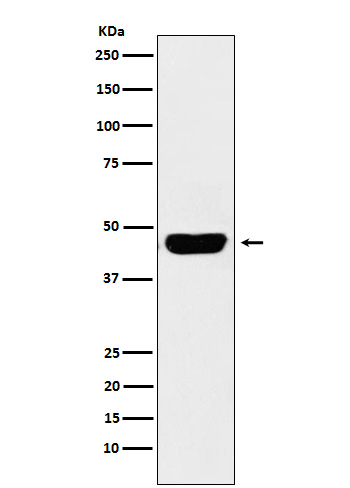
| WB | 1/500-1/1000 | Human,Mouse,Rat |
| IF | 咨询技术 | Human,Mouse,Rat |
| IHC | 咨询技术 | Human,Mouse,Rat |
| ICC | 技术咨询 | Human,Mouse,Rat |
| FCM | 1/50-1/100 | Human,Mouse,Rat |
| Elisa | 咨询技术 | Human,Mouse,Rat |
| Aliases | TNFRSF4; TXGP1L; Tumor necrosis factor receptor superfamily member 4; ACT35 antigen; OX40L receptor; TAX transcriptionally-activated glycoprotein 1 receptor; CD antigen CD134 |
| Entrez GeneID | 7293 |
| WB Predicted band size | Calculated MW: 29 kDa; Observed MW: 45 kDa |
| Host/Isotype | Rabbit IgG |
| Antibody Type | Primary antibody |
| Storage | Store at 4°C short term. Aliquot and store at -20°C long term. Avoid freeze/thaw cycles. |
| Species Reactivity | Human |
| Immunogen | A synthesized peptide derived from human CD134 |
| Formulation | Purified antibody in PBS with 0.05% sodium azide. |
+ +
以下是3-4篇关于CD134/OX40/OX40L抗体的代表性文献摘要:
1. **"OX40 (CD134) costimulation enhances T cell activation by promoting cell cycle progression"**
- **作者**: Piconese S, et al.
- **摘要**: 研究OX40激动型抗体通过结合T细胞表面的OX40受体,增强T细胞活化和增殖,促进细胞周期蛋白(如cyclin D3)表达,为抗肿瘤免疫治疗提供机制支持。
2. **"Targeting the OX40/OX40L pathway in autoimmune diseases"**
- **作者**: Aspeslagh S, et al.
- **摘要**: 综述OX40/OX40L信号在自身免疫疾病中的作用,探讨阻断型抗体(如抗OX40L单抗)通过抑制T细胞与抗原呈递细胞的相互作用,缓解类风湿性关节炎和炎症性肠病等疾病的实验证据。
3. **"Agonistic anti-CD134 (OX40) antibody enhances vaccine-induced CD8+ T cell immunity and tumor protection"**
- **作者**: Lin GH, et al.
- **摘要**: 在小鼠模型中,激动型抗CD134抗体联合疫苗可显著增强抗原特异性CD8+ T细胞应答,延长存活时间并抑制肿瘤生长,突显其在癌症免疫联合治疗中的潜力。
4. **"OX40L blockade inhibits allergic inflammation by targeting Th2 responses via multiple mechanisms"**
- **作者**: Hirata H, et al.
- **摘要**: 抗OX40L抗体通过抑制Th2细胞分化和细胞因子(如IL-4/IL-13)分泌,减轻哮喘模型中的气道高反应性和炎症,支持其在过敏性疾病中的治疗价值。
(注:以上文献为领域内代表性方向示例,实际引用时需核对具体文献信息。)
CD134 (OX40) is a co-stimulatory receptor belonging to the tumor necrosis factor receptor (TNFR) superfamily, primarily expressed on activated CD4+ and CD8+ T cells, regulatory T cells (Tregs), and natural killer (NK) cells. Its ligand, OX40L (CD252), is found on antigen-presenting cells (APCs), endothelial cells, and activated T/B cells. The OX40/OX40L interaction plays a critical role in enhancing T cell survival, proliferation, and cytokine production, while inhibiting Treg suppression, thereby shaping adaptive immune responses. Dysregulation of this pathway is implicated in autoimmune diseases, chronic inflammation, and cancer.
Antibodies targeting OX40/OX40L are designed to modulate this pathway for therapeutic benefit. Agonistic anti-OX40 antibodies (e.g., MOXR0916. PF-04518600) aim to boost anti-tumor immunity by activating effector T cells, often explored in cancer immunotherapy. Conversely, antagonistic anti-OX40 or anti-OX40L antibodies (e.g., KHK4083. KY1005) aim to suppress pathogenic T cell responses in autoimmune or inflammatory conditions like atopic dermatitis or inflammatory bowel disease. Structural studies reveal these antibodies typically bind the receptor’s cysteine-rich domains (CRDs) or ligand interfaces, either mimicking ligand-induced clustering (agonists) or blocking ligand-receptor engagement (antagonists).
Current clinical trials highlight their potential, though challenges remain, including balancing efficacy with immune-related adverse events (irAEs) and optimizing combinatorial regimens. Research continues to refine antibody engineering (e.g., Fc modifications for enhanced specificity) and biomarker-driven patient stratification.
×